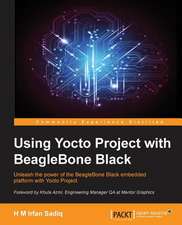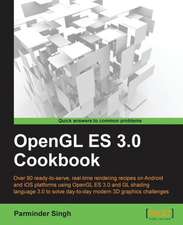asyncio Recipes: A Problem-Solution Approach
Autor Mohamed Mustapha Tahriouien Limba Engleză Paperback – 22 mai 2019
Get the most out of asyncio and find solutions to your most troubling Python programming problems. This book offers a pragmatic collection of recipes by going beyond online resources and docs to provide guidance on using this complex library. As such, you’ll see how to improve application performance and run computationally intensive programs faster.
asyncio Recipes starts with examples illustrating the primitives that come with the asyncio library, and explains how to determine if asyncio is the right choice for your application. It shows how to use asyncio to yield performance gains without multiple threads, and identifies common mistakes and how to prevent them. Later chapters cover error-handling, testing, and debugging. By the end of this book, you'll understand how asyncio runs behind the scenes, and be confident enough to contribute to asyncio-first projects.
What You Will Learn
- Discover quirky APIs such as the event loop policies
- Write asyncio code with native coroutines
- Use the ast module to find legacy asyncio code
- Work with contextvars
- See what a async context manager is and why a lot of asyncio APIs use them
Who This Book Is For
Experienced Python developers or hobbyists who want to understand asyncio and speed up their applications by adding concurrency to their toolkit.
Preț: 183.20 lei
Preț vechi: 229.01 lei
-20% Nou
Puncte Express: 275
Preț estimativ în valută:
35.06€ • 37.49$ • 29.23£
35.06€ • 37.49$ • 29.23£
Carte disponibilă
Livrare economică 27 martie-10 aprilie
Preluare comenzi: 021 569.72.76
Specificații
ISBN-13: 9781484244005
ISBN-10: 1484244001
Pagini: 350
Ilustrații: XXVI, 315 p. 5 illus.
Dimensiuni: 155 x 235 mm
Greutate: 0.48 kg
Ediția:1st ed.
Editura: Apress
Colecția Apress
Locul publicării:Berkeley, CA, United States
ISBN-10: 1484244001
Pagini: 350
Ilustrații: XXVI, 315 p. 5 illus.
Dimensiuni: 155 x 235 mm
Greutate: 0.48 kg
Ediția:1st ed.
Editura: Apress
Colecția Apress
Locul publicării:Berkeley, CA, United States
Cuprins
Chapter 1: Preparing for the Recipes .- Chapter 2: Working with Event Loops.- Chapter 3: Working with Coroutines and async/await.- Chapter 4: Working with async Generators.- Chapter 5: Working with async Context Manager.- Chapter 6: Communication Between asyncio Components.- Chapter 7: Synchronization Between asyncio Components.- Chapter 8: Improving asyncio Applications.- Chapter 9: Working with Network Protocols.- Chapter 10: Preventing Common asyncio Mistakes.- Appendix A: Setting up Your Environment.- Appendix B: Event Loops OS Specifics
Notă biografică
Mohamed Mustapha Tahrioui has been a programmer for seven years and currently serves as a senior software engineer at axxessio, where he works as a team lead on asyncio heavy projects, utilizing his expertise for backward compatible architecture and implementation. He also offers full stack development via his IT consultancy Pi Intelligence, using Python, Java, JavaScript, Docker, PostgreSQL, MongoDB, and more.
Said El Mallouki is a textbook computer geek with decades of experience designing and developing enterprise IT systems. His early encounters with the internals of computers took place at IBM's production facility in Germany more than two decades ago. In his current occupation as a technology lead, he works on innovative, cutting edge projects.
The intricacies of complex distributed systems have always been on the top of his interest list. With three degrees in IT, business, and marketing, he combines a solid theoretical foundation with plenty ofreal-life experience.
He lives by the Rhine in Germany with his wife Andrea and their 18-month-old son, Felix. His current favorite leisure activity is to be a devoted father.
Said El Mallouki is a textbook computer geek with decades of experience designing and developing enterprise IT systems. His early encounters with the internals of computers took place at IBM's production facility in Germany more than two decades ago. In his current occupation as a technology lead, he works on innovative, cutting edge projects.
The intricacies of complex distributed systems have always been on the top of his interest list. With three degrees in IT, business, and marketing, he combines a solid theoretical foundation with plenty ofreal-life experience.
He lives by the Rhine in Germany with his wife Andrea and their 18-month-old son, Felix. His current favorite leisure activity is to be a devoted father.
Textul de pe ultima copertă
Get the most out of asyncio and find solutions to your most troubling Python programming problems. This book offers a pragmatic collection of recipes by going beyond online resources and docs to provide guidance on using this complex library. As such, you’ll see how to improve application performance and run run I/O intensive programs faster.
asyncio Recipes starts with examples illustrating the primitives that come with the asyncio library, and explains how to determine if asyncio is the right choice for your application. It shows how to use asyncio to yield performance gains without multiple threads, and identifies common mistakes and how to prevent them. Later chapters cover error-handling, testing, and debugging. By the end of this book, you'll understand how asyncio runs behind the scenes, and be confident enough to contribute to asyncio-first projects.
Caracteristici
A hands-on guide focused on explaining asyncio internals and developing working applications Entry-level coverage of asyncio that presumes experience with Python fundamentals and ramps up quickly Includes illustrative examples and full-chapter labs to challenge readers' understanding of concepts























